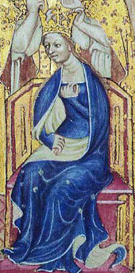
Westminster is a city and area of Central London, England, within the larger City of Westminster, most notable for being the seat of the majority of government institutions in the United Kingdom.
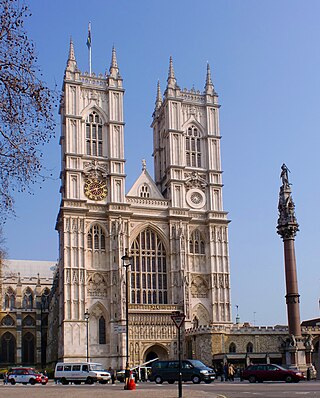
Westminster Abbey, formally titled the Collegiate Church of Saint Peter at Westminster, is an Anglican church in the City of Westminster, London, England. Since 1066, it has been the location of the coronations of 39 English and British monarchs, and a burial site for 18 English, Scottish and British monarchs. At least 16 royal weddings have occurred at the abbey since 1100.
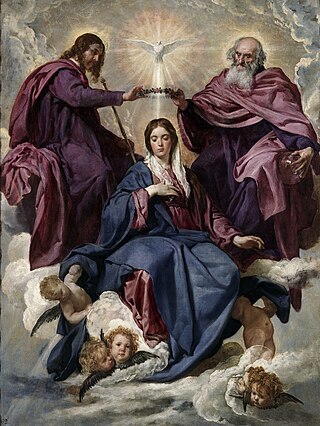
Queen of Heaven is a title given to the Virgin Mary, by Christians mainly of the Catholic Church and, to a lesser extent, in Anglicanism, Lutheranism, and Eastern Orthodoxy. The title has long been a tradition, included in prayers and devotional literature and seen in Western art in the subject of the Coronation of the Virgin from the High Middle Ages, long before it was given a formal definition status by the Church.

The Crown Jewels of the United Kingdom, originally the Crown Jewels of England, are a collection of royal ceremonial objects kept in the Tower of London, which include the coronation regalia and vestments worn by British monarchs.
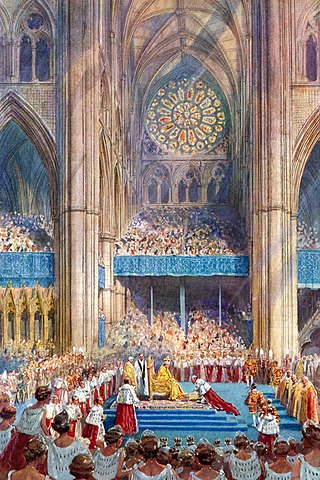
The coronation of the monarch of the United Kingdom is a ceremony in which they are formally invested with regalia and crowned at Westminster Abbey. It corresponds to the coronations that formerly took place in other European monarchies, all of which have abandoned coronations in favour of inauguration or enthronement ceremonies. A coronation is a symbolic formality and does not signify the official beginning of the monarch's reign; de jure and de facto their reign commences from the moment of the preceding monarch's death, maintaining the legal continuity of the monarchy.

The Coronation Chair, known historically as St Edward's Chair or King Edward's Chair, is an ancient wooden chair on which British monarchs sit when they are invested with regalia and crowned at their coronations. It was commissioned in 1296 by King Edward I to contain the coronation stone of Scotland—known as the Stone of Destiny—which had been captured from the Scots who kept it at Scone Abbey. The chair was named after Edward the Confessor, and was previously kept in his shrine at Westminster Abbey.
Owen Oglethorpe was an English academic and Roman Catholic Bishop of Carlisle, 1557–1559.
Robert Parsons was an English composer of the Tudor period who was active during the reigns of King Edward VI, Queen Mary I and Queen Elizabeth I. He is noted for his compositions of church music.

Sir John Frederick Bridge was an English organist, composer, teacher and writer.
Alan Campbell Don was a trustee of the National Portrait Gallery, editor of the Scottish Episcopal Church's 1929 Scottish Prayer Book, chaplain and secretary to Cosmo Lang, Archbishop of Canterbury, from 1931 to 1941, Chaplain to the Speaker of the House of Commons from 1936 to 1946 and Dean of Westminster from 1946 to 1959.

The Liber Eliensis is a 12th-century English chronicle and history, written in Latin. Composed in three books, it was written at Ely Abbey on the island of Ely in the fenlands of eastern Cambridgeshire. Ely Abbey became the cathedral of a newly formed bishopric in 1109. Traditionally the author of the anonymous work has been given as Richard or Thomas, two monks at Ely, one of whom, Richard, has been identified with an official of the monastery, but some historians hold that neither Richard nor Thomas was the author.

The coronation of Elizabeth II as Queen of the United Kingdom and the other Commonwealth realms took place on 2 June 1953 at Westminster Abbey in London. She acceded to the throne at the age of 25 upon the death of her father, George VI, on 6 February 1952, being proclaimed queen by her privy and executive councils shortly afterwards. The coronation was held more than one year later because of the tradition of allowing an appropriate length of time to pass after a monarch dies before holding such festivals. It also gave the planning committees adequate time to make preparations for the ceremony. During the service, Elizabeth took an oath, was anointed with holy oil, was invested with robes and regalia, and was crowned Queen of the United Kingdom, Canada, Australia, New Zealand, South Africa, Pakistan, and Ceylon.

The Coronation of Edward VII, also released as Reproduction, Coronation Ceremonies, King Edward VII and as Coronation of King Edward, is a 1902 short silent film directed by Georges Méliès and produced by Charles Urban. The film is a staged simulation of the coronation of King Edward VII and Queen Alexandra, produced in advance of the actual coronation for release on the same day.
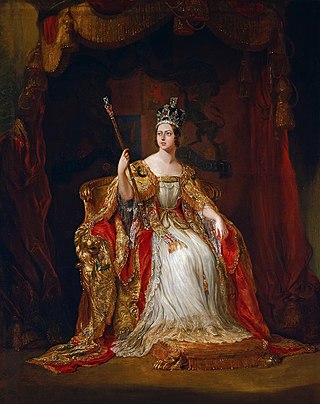
The coronation of Victoria as Queen of the United Kingdom took place on Thursday, 28 June 1838, just over a year after she succeeded to the throne of the United Kingdom at the age of 18. The ceremony was held in Westminster Abbey after a public procession through the streets from Buckingham Palace, to which the Queen returned later as part of a second procession.

The coronation of George VI and his wife, Elizabeth, as King and Queen of the United Kingdom and the Dominions of the British Commonwealth, and as Emperor and Empress of India took place at Westminster Abbey, London, on Wednesday 12 May 1937. George VI ascended the throne upon the abdication of his brother, Edward VIII, on 11 December 1936, three days before his 41st birthday. Edward's coronation had been planned for 12 May and it was decided to continue with his brother and sister-in-law's coronation on the same date.
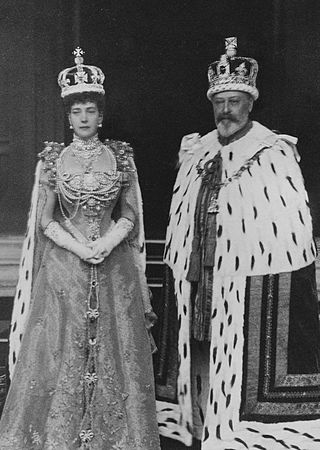
The coronation of Edward VII and his wife, Alexandra, as King and Queen of the United Kingdom and the British Dominions, and as Emperor and Empress of India took place at Westminster Abbey, London, on 9 August 1902. Originally scheduled for 26 June of that year, the ceremony had been postponed at very short notice, because the King had been taken ill with an abdominal abscess that required immediate surgery. In contrast to the coronation of Queen Victoria, Edward's predecessor, some 64 years earlier, Edward and Alexandra's coronation had been carefully planned as a spectacle reflecting the influence and culture of the British Empire, then at the height of its power, but also as a meaningful religious occasion.

The coronation of Elizabeth I as Queen of England and Ireland took place at Westminster Abbey, London, on 15 January 1559. Elizabeth I had ascended the throne at the age of 25 upon the death of her half-sister, Mary I, on 17 November 1558. Mary had reversed the Protestant Reformation which had been started by her two predecessors, so this was the last coronation in Great Britain to be conducted under the authority of the Roman Catholic Church. Historians view Elizabeth's coronation as a statement of her intention to restore England to Protestantism, but to allow the continuation of some Catholic customs, a compromise known as the Elizabethan Settlement.

The coronation of George V and his wife Mary as King and Queen of the United Kingdom and the British Dominions, and as Emperor and Empress of India, took place at Westminster Abbey, London, on Thursday 22 June 1911. This was the second of four such events held during the 20th century and the last to be attended by royal representatives of the great continental European empires.

The coronation of James I and his wife Anne as King and Queen of England was held on 25 July 1603 at Westminster Abbey. James had reigned as King James VI of Scotland since 1567. Anne was anointed and consecrated with prayers alluding to Esther, the Wise Virgins, and other Biblical heroines. It was the first coronation to be conducted in English instead of Latin. A planned ceremonial Royal Entry to London was deferred until 15 March 1604.

The coronation of Charles III and his wife, Camilla, as king and queen of the United Kingdom and the other Commonwealth realms is scheduled to take place on Saturday, 6 May 2023, at Westminster Abbey. Charles acceded to the throne on 8 September 2022, upon the death of his mother, Elizabeth II.
